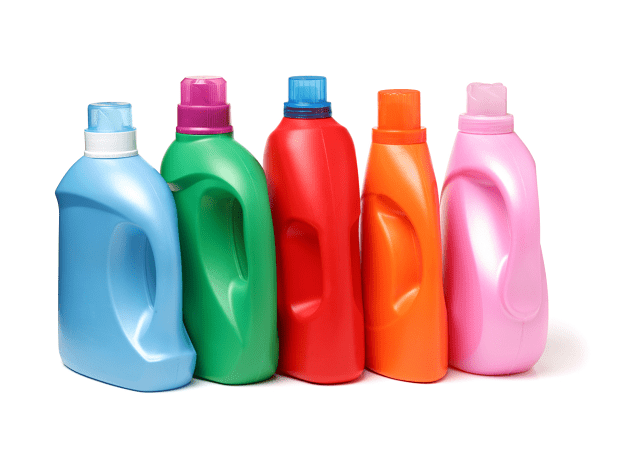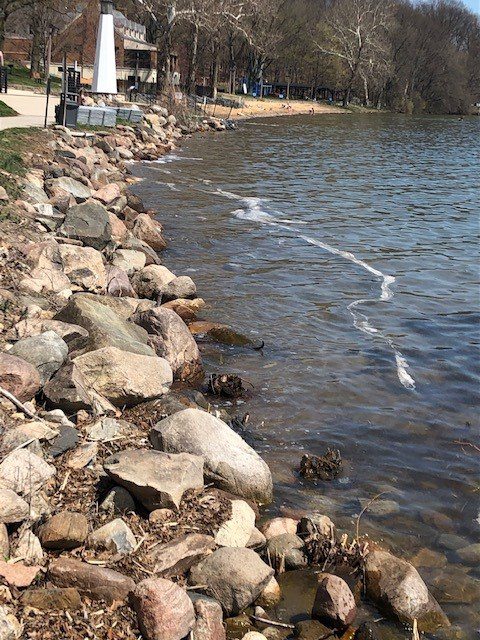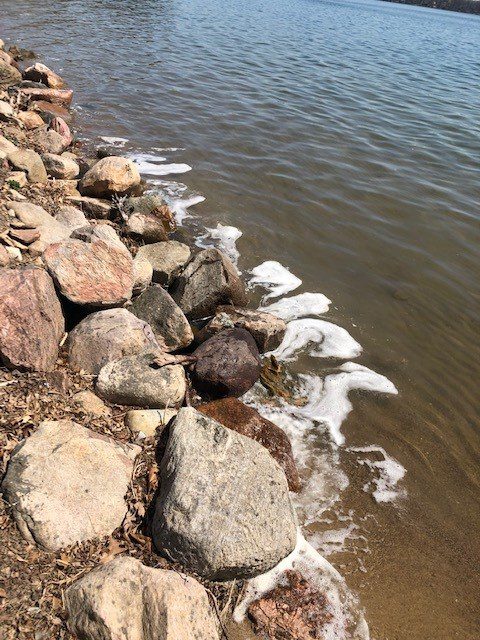If you were lucky enough to be in Culver last week enjoying the beautiful weather, I hope you were able to take a stroll along the lakeshore. You may have noticed the foam along the shoreline and wondered where it came from and if it is a cause for concern.

Laundry Soap of YesterYear
Back in the day, it was common to see foam on waterways caused by laundry detergents,. These detergents from that era were highly resistant to chemical breakdown. Now the sudsing agent of all detergents must be biodegradable. This means that they quickly lose their ability to cause foaming, are unable to produce the long-lasting foam found along the shoreline and are unlikely to be the source of the foam seen in these photos. In addition, almost all the houses around the lake have switched over from septic to sewer so laundry gray water is (hopefully) not being discharged into the lake.
Organic Matter is Typically the Culprit

All lakes contain organic matter, like algae and plants. When the plants die and decompose, the oils contained in the plant cells are released and float to the surface. Gusty spring winds contribute to churning the water, bringing nutrient rich water from deeper waters to the surface, agitating all this organic matter into a sudsy white or tan foam.
Characteristics
The foam often forms parallel streaks caused by wind-induced surface currents. Natural foam has a somewhat earthy fishy aroma and may have an off-white, tan, or brown color. Detergent foam in contrast will have a noticeable perfume smell and is usually much more white in color.
PFAS Foam
New to the discussion is foam caused by PFAS. The Lilly Center for Lakes and Streams wrote a nice article about PFAS here. Scientists are still studying why and how PFAS foam appears in some lakes and streams and not in others.
There are some ways you can distinguish PFAS foam from naturally occurring foam. Generally, PFAS foam:
- is bright white
- is usually lightweight
- can be sticky
- tends to pile up like shaving cream
- can blow onto the beach
Being in contact with water containing PFAS is not considered harmful because the amount of PFAS is typically low and an accidental swallow of river or lake water is not a health concern.
“Although current science shows that the risk of PFAS getting into your system from contact with skin is low, you can minimize exposure to PFAS by rinsing or showering after you are done with your recreational activities,” said Dr. Joneigh Khaldun, chief medical executive and chief deputy for health at Michigan Department of Health and Human Services (MDHHS) “In general, washing hands and rinsing off after recreating will help to protect people from chemicals and bacteria that may be in water bodies.”
Conclusion
Foam is a naturally occurring phenomenon on any lake and generally not a cause for concern.

Hi, I’m Debbie Palmer. I received a BS in Horticulture from Purdue University. Here at LMEF, I am responsible for outreach presentations, monitoring the lake and it’s wetlands, project manager for restoration and research projects, and act as a community resource for all things related to the well-being of Lake Maxinkuckee and its surrounding watershed. I completed Indiana Watershed Leadership Academy, volunteer with the Indiana Clean Lakes Program, Hoosier River Watch and Marshall County Lakes and Waters and serve as a Board Member for Indiana Lakes Management Society.


Recent Comments